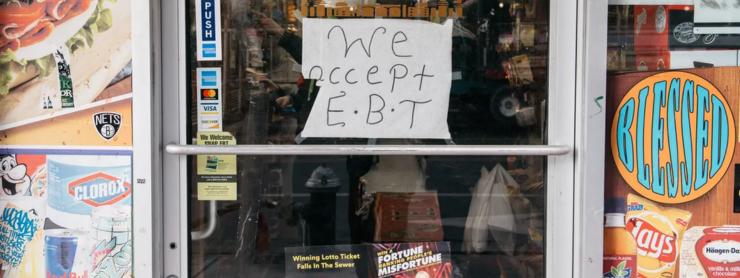House Speaker Kevin McCarthy’s recent attempt to hold the federal debt ceiling hostage included a proposal to reduce eligibility for the Supplemental Nutrition Assistance Program, also known as SNAP. Administered by the US Department of Agriculture, the SNAP program provides households hovering near or below the poverty line the means to purchase food with federal dollars loaded onto EBT cards. In a nation that annually generates more than 80 million tons of food waste, all while allowing millions to go hungry, it may seem odd that politicians like McCarthy would want to take away Americans’ access to food, but this recent effort is just one of many that have become all too common.
Last December, with the passage of an omnibus spending bill, the Democratic-led Congress chose to cut emergency food assistance for these same SNAP recipients. This bill ended the “emergency allotments” of SNAP dollars originally authorized in March 2020, during the prelude to what would become a years-long battle with the job loss and food insecurity caused by the COVID-19 pandemic. Even though researchers credited this increased funding with keeping 4.2 million recipients above the poverty line, and even though an estimated 34 million Americans still do not have enough to eat, the federal government has nevertheless decided to claw back at least $95 per month from the nation’s most impoverished households. To put this in perspective, that is more than the average cost to feed a single teenage boy in one week.
Mainstream media outlets have sold this budgetary decision as a “trade-off” that allowed summer meal programs for low-income children, lauding the fact that the omnibus bill, while removing money from some household budgets, did in turn add back a monthly benefit of $40 per child. The Center on Budget and Policy Priorities, however, estimates that an average 3-person family would lose $197 per month due to this change; thus, this “trade-off” will result in a net loss for most families, a loss felt more keenly due to lingering inflation and a looming interest-rate-induced recession.
Of course, media outlets don’t use the word “trade-off” in relation to other items in the bill, including the $858 billion in defense spending. The emergency nutrition dollars were allocated in phases throughout the pandemic, beginning with the extra $2 billion per month in March 2020. Later increases resulted from the American Rescue Plan and a 2021 executive order. The end of the emergency funding is expected to decrease the SNAP budget by $32 billion between FY 2023 and FY 2024, less than the $45 billion this same bill allocated to bolster Ukraine’s military and economy. SNAP’s federal funding will hit its peak with an estimated budget of $154 billion for the current fiscal year, but that cost pales in comparison to many military programs, including the interminable F-35 Joint Strike Fighter program, which is estimated to cost a whopping $1.7 trillion before its completion. Neither the Ukrainian proxy war nor Lockheed Martin, which produces and sells each F-35 for the current retail price of $77.9 million, must endure any trade-offs for continued funding.
Playing the Congressional Hunger Game
In the 2020 book “The Deficit Myth: Modern Monetary Theory and the Birth of the People’s Economy,” economist Stephanie Kelton provides a detailed description of the games Congressional staffers must play to make trade-offs for proposed domestic spending like nutrition assistance. During her time as the chief economist for the US Senate Budget Committee, Kelton witnessed a single University of Texas law professor named Calvin Johnson become the “one-stop shop” for providing “pay-fors” to fund domestic priorities:
“Shopping for pay-fors went something like this: ‘Hi, I’m a staffer in Senator X’s office. The senator needs $350 billion over ten years. What have you got?’ Johnson might recommend a single change to some part of the tax code that would raise the full $350 billion. Or, he might pull down a few binders that, together, would generate the full amount. Six-of-one, half-a-dozen of the other. The goal was to find your boss enough revenue to play the game.”
Interestingly, Kelton suggests these game rules don’t apply when Congress considers military spending. Kelton recounts the ease with which the National Defense Authorization Act of 2017 “sailed through the Senate.” Kelton writes, “The White House had requested $700 billion, but the Senate authorized $737 billion, kicking in an extra $37 billion without a hint of concern about where to ‘find’ the money.” As the newest $858 billion Pentagon windfall reveals, purchasing weapons of war never requires the same money-foraging required to alleviate domestic problems like hunger. And once those weapons of war are purchased, monitoring their use through inventory control is apparently optional.
The treatment of domestic spending as a cut-throat competition where only the best program can win and military spending as a recreational sport where every weapons manufacturer gets a participation trophy divulges a truth that many politicians refuse to admit, namely, that the United States government creates and issues its own dollars, and the real restraints on federal spending are not due to a lack of those dollars. The US Congress, with its staffers scouring the tax code, playing hide-and-seek with unclosed loopholes, could in effect abandon the pretense of “pay-fors” and fund its domestic priorities just like they do for defense spending. The fact that the military continues to receive full funding—often more than full funding—is a direct reflection of what matters most to our elected representatives. In their minds, a $1.7 trillion contract with Lockheed Martin takes precedence over a $154 billion program that feeds people. For House Speaker McCarthy, the debt ceiling is only problematic when we increase spending on services that keep Americans healthy, nourished, and alive.
Can Larry Summers Eat 50 Eggs?
Most mainstream economists understand the truth about federal funding, knowing that technically the US government does not have a limited supply of dollars and that the constant “crisis” caused by the debt ceiling is, at best, silly, yet they still proclaim that the US government should restrict its issuance of dollars due to the risk of inflation. MMT economists like Kelton would agree that inflation can occur when aggregate demand outpaces the supply of a particular resource. Such was the case at varying points throughout the COVID-19 pandemic when federal stimulus spending kept enough money in people’s pockets to keep demand steady while supplies of everyday goods like butter, eggs, and baby formula dwindled. In these examples, however, increased demand did not cause these shortages or the high prices affecting these goods. Rather, the temporary inflation of these essential commodities resulted from a series of severe supply-side disruptions — specifically, a global decline in milk output, an avian flu epidemic, and a national product recall. After the disruptions had ended and consumers’ previous expectations for low prices had vanished, corporate price-gouging continued to keep inflation high.
Nevertheless, neoclassical economists like Larry Summers still point to stimulus spending, including the emergency allotments of SNAP benefits, as the main cause of inflation, suggesting that the extra money and benefits Americans received increased demand for groceries and other goods. Taking heed, members of Congress have used inflation as a rallying cry for their ongoing battle against domestic spending. As much as Americans appreciate their representatives taking advice from Jeffrey Epstein’s personal friend, a man who imperiously extols the virtues of high unemployment while nestled in a cushy chair on a tropical resort, there remains the fact that other economists have determined that additional demand played only a small part in the rising inflation of the past year. In fact, the San Francisco Fed has revealed that demand’s impact on recent inflation was not as large as corporate profits and supply issues, which accounted for two-thirds of the problem. Removed from practical, everyday concerns like grocery shopping, elites like Larry Summers don’t realize that extra money does not drive demand for necessities, especially those with a limited shelf life. People don’t buy an extra few dozen eggs just because they have more grocery money. Nobody can eat 50 eggs.
Although it may seem egregious for elites to lie to cash-strapped Americans, insisting they must sacrifice their families’ access to food so the federal government can battle an imaginary debt crisis, curb inflation and keep the lights on at Lockheed Martin, some of the most irrational and duplicitous attempts to cut SNAP benefits have been occurring in smaller venues, in state legislatures like Iowa.
Wasting State Funds to Means-Test Federal Food Dollars
One key tenet of Modern Monetary Theory is the distinction that exists between currency issuers and currency users. As Kelton points out, “The US Constitution grants the federal government the exclusive right to issue the currency.” Kelton further explains that since the Nixon administration ended the Bretton Woods system, the United States has had a “purely fiat currency,” meaning the US dollar has no fixed value, is no longer backed by gold or any other commodity, and is considered legal tender because the US government says so. Because the US government has a monopoly on creating this legal tender and no longer needs to use gold reserves as collateral for its dollars, Kelton argues that it is “impossible” for the United States government to run out of money. States, on the other hand, are currency users, just like households or businesses or any other entity that lacks the legal authority to create money. As such, states can only collect dollars through tax revenue or from direct funding from the federal government.
This year the Iowa legislature passed Senate File 494, which uses state funds to complicate the state’s administration of the federal SNAP program. A previous House version of the bill imposed severe restrictions on the types of food that beneficiaries could purchase, including purported luxuries like butter, flour, and cottage cheese. After an outcry from constituents and anti-hunger advocates, the Iowa Senate revised the bill to its current form, which includes an asset test and a new identity verification system.
In 2013 the state of Florida offered a 3-year $2.9 million-dollar contract to Lexis Nexis to create exactly that kind of system. Identity authentication systems like the one provided by Lexis Nexis require people to answer questions from publicly available information about their past, questions like “Which of these addresses have you lived in?” or “Which of these vehicles were once registered in your name?” While the concept of identity verification may sound good in theory, the fact that 31% of Iowa’s SNAP households include elderly or disabled individuals suggests a future barrier for some eligible people who may find these questions difficult. While some of us may fondly remember the 1986 Oldsmobile that left us stranded on the highway when we were 19, many qualified SNAP applicants, especially those who are elderly or cognitively impaired, or whose transportation history includes a long litany of broken-down cars, may not.
The asset test will require that applicants’ assets, excluding the value of a car or home, total no more than $15,000. Prior to determining if an applicant is eligible for benefits, SF 494 requires employees at the Iowa Department of Health & Human Services (HHS) to reference a checklist of at least 20 different federal, state, and miscellaneous data sources, including the IRS, death registration databases, lottery databases, child support databases, and employment databases, to determine eligibility. HHS employees will need to conduct these checks on every member of an applicant’s household.
As any person who has worked with data at a state agency can tell you, for security purposes, data between various state and federal entities is not freely shared, nor is it easily accessed, often stored in outdated databases that employees from one entity can only access via request to another entity, rather than with direct logins or APIs. Envision an army of civil servants submitting web forms, passing encrypted spreadsheets back and forth, uploading said spreadsheets into a new management system, pulling reports, analyzing discrepancies, stopping long enough for coffee breaks and occasional staff meetings. Each prospective SNAP household will need to wait while a web of bureaucracy tangles and untangles itself to determine if the people within that household can eat. In addition to being cruel, this process will be a waste of human energy from HHS employees, essentially a manifestation of the late David Graeber’s worst nightmare. Ironically, Iowa’s Legislative Services Agency (LSA) estimates that the bill, which proponents praise as a tool for eliminating government waste, will increase the headcount at the HHS from 37 to 218 people.
While no state is accountable for the federal SNAP dollars disbursed to recipients, states do share the cost of program administration. In the words of an LSA analysis of this bill, “SNAP funding for benefits is received from the federal government; however, 50.0% of administrative costs are paid by the State.” The LSA calls out that in FY 2022, Iowa’s HHS paid $2.2 million from the General Fund for SNAP administration, including IT costs. Thus, the passing of SF 494, with its heightened complexity, cumbersome technology, and growing staff count, will actually increase the total dollars the currency-using state of Iowa must spend on the SNAP program, which provides dollars from the federal government, the currency issuer.
The bill proposes the use of this new system to means-test Medicaid and the Children’s Health Insurance Program (CHIP) as well. Since these are federal programs for which the state does bear some cost, the desire to validate eligibility perhaps makes more sense, if you are a person who cares more about saving state dollars than increasing the health and wellbeing of children and families. But even the state’s projected savings, which the LSA estimated would occur only after an initial investment of $7.5 million, would not be realized until FY2027. In the meantime, while the state waits for those savings — which are only a projection — this bill will have increased the size of a state agency, lined the pockets of an out-of-state IT vendor, and prevented an estimated 10,000 Iowans from receiving the health care and nutrition assistance they need to survive. Currently, the bill awaits the signature of Governor Kim Reynolds. Anti-hunger advocates are calling on her to veto the bill.
None of these fiscal factors even address the nonsensical cruelty of intentionally creating barriers for children, families, and seniors needing access to food. In a nation where 38% of the food supply remains unsold and uneaten, often left to molder in unpicked fields or rot in overflowing dumpsters, the fact that 34 million Americans suffer from hunger is a symptom of a sick and decaying culture. Even if state and federal leaders are mired in the false premise that funding food assistance could precipitate a debt crisis or worsen inflation or take money from state coffers, the fact that stressors like food insecurity can cause mental illness as well as cardiovascular disease and death should motivate them to prioritize feeding people. Inadequate access to nutrition is a problem Americans can solve. It’s time to shut down the false narratives that prevent us from fully funding the SNAP program. The price of hunger is too exorbitant to pay.






There’s something about spending state dollars to help save money for the federal government. Let’s see now… the state is cash-strapped while the federal government can create as much currency as it needs. What’s wrong with this picture?
Great article! Virtually everything that #Congress does is based on ideas from economic charlatans like #LarrySummers. #LearnMMT
Thank you for this manuscript. I’m going to share it out. In healthcare, I see the same thing happening: the fed grant money goes to increasing the number of administrators and to researchers to “study” the problem, NOT to those who need care urgently. Back in Mar 2020, the HHS and Labor Dept cajoled our state agency heads for not “looking harder ” to utilize available federal grant money. At the time seemed silly to me to set up such barriers, but I’ve come to understand it’s a feature, not a bug.